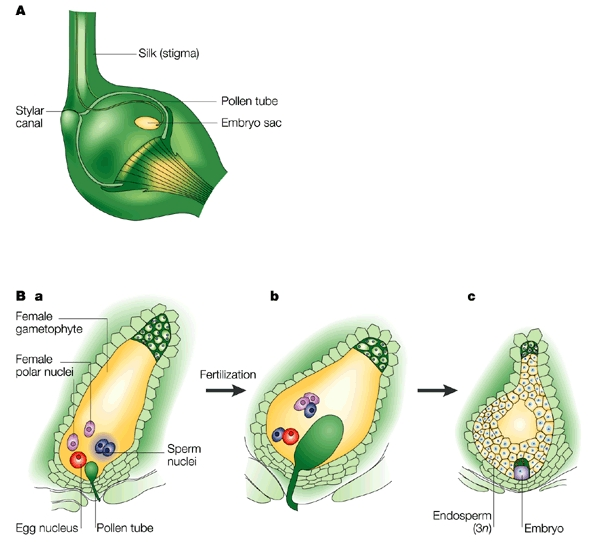
Draw a labelled diagram of a fertilized embryo sac in an angiosperm?
Answer
473.7k+ views
Hint: The interaction between male and female gametophytes (the pollen tube and the embryo sac respectively) in angiosperm plants results in double fertilization. The pollen tube delivers two male gametes into the embryo sac. One of the male gametes fuses with the egg cell to form the embryo. The second sperm cell fuses with the central cell to form the endosperm.
Complete step by step answer: Fertilization in angiosperms is double fertilization. It is a complex fertilization mechanism which involves the fusion of a female gametophyte (or megagametophyte or the embryo sac) and two male gametes (or sperm). When a pollen grain adheres to the stigma of the carpel (the female reproductive structure of a flower), it begins to germinate. It forms a pollen tube extending downwards towards the ovary through style. The pollen tube then enters the ovary and penetrates through the micropyle opening inside the ovule. The pollen tube releases two sperms in the embryo sac.
The unfertilized ovule has eight cells which are arranged in the form of 3+2+3, namely, 3 antipodal cells, 2 polar central cells, 2 synergids and 1 egg cell. One of the sperm fertilizes the egg cell and the other fuses with the two polar nuclei of the large central cell of the embryo sac. The haploid sperm and haploid egg fuse to form a diploid zygote and the process is known as syngamy. The other sperm fuses with two haploid polar nuclei of the large central cell to form a triploid nucleus resulting in triple fusion. The large cell of the gametophyte develops into the endosperm, which is a nutrient-rich tissue to provide nourishment to the developing embryo. The ovary, which surrounds the ovules, then develops into the fruit. It protects the seeds and also functions to disperse them.

Additional information:
The two central cell maternal nuclei, also known as polar nuclei arise by mitosis from the same single meiotic process that gives rise to the egg. Therefore, the maternal contribution to the genetic constitution of a triploid endosperm is double than that of the embryo.
Note: In-vitro double fertilization is used to study the molecular interactions and other aspects of gamete fusion in angiosperms. One of the major complications in developing in-vitro double fertilization between the male and female gametes is the confinement of sperms in the pollen tube and egg in the embryo sac.
Complete step by step answer: Fertilization in angiosperms is double fertilization. It is a complex fertilization mechanism which involves the fusion of a female gametophyte (or megagametophyte or the embryo sac) and two male gametes (or sperm). When a pollen grain adheres to the stigma of the carpel (the female reproductive structure of a flower), it begins to germinate. It forms a pollen tube extending downwards towards the ovary through style. The pollen tube then enters the ovary and penetrates through the micropyle opening inside the ovule. The pollen tube releases two sperms in the embryo sac.
The unfertilized ovule has eight cells which are arranged in the form of 3+2+3, namely, 3 antipodal cells, 2 polar central cells, 2 synergids and 1 egg cell. One of the sperm fertilizes the egg cell and the other fuses with the two polar nuclei of the large central cell of the embryo sac. The haploid sperm and haploid egg fuse to form a diploid zygote and the process is known as syngamy. The other sperm fuses with two haploid polar nuclei of the large central cell to form a triploid nucleus resulting in triple fusion. The large cell of the gametophyte develops into the endosperm, which is a nutrient-rich tissue to provide nourishment to the developing embryo. The ovary, which surrounds the ovules, then develops into the fruit. It protects the seeds and also functions to disperse them.

Additional information:
The two central cell maternal nuclei, also known as polar nuclei arise by mitosis from the same single meiotic process that gives rise to the egg. Therefore, the maternal contribution to the genetic constitution of a triploid endosperm is double than that of the embryo.
Note: In-vitro double fertilization is used to study the molecular interactions and other aspects of gamete fusion in angiosperms. One of the major complications in developing in-vitro double fertilization between the male and female gametes is the confinement of sperms in the pollen tube and egg in the embryo sac.
Recently Updated Pages
Master Class 12 Business Studies: Engaging Questions & Answers for Success

Master Class 12 English: Engaging Questions & Answers for Success

Master Class 12 Social Science: Engaging Questions & Answers for Success

Master Class 12 Chemistry: Engaging Questions & Answers for Success

Class 12 Question and Answer - Your Ultimate Solutions Guide

Master Class 12 Economics: Engaging Questions & Answers for Success

Trending doubts
Give 10 examples of unisexual and bisexual flowers

Draw a labelled sketch of the human eye class 12 physics CBSE

Differentiate between homogeneous and heterogeneous class 12 chemistry CBSE

Write a short note on Franklands reaction class 12 chemistry CBSE

Differentiate between insitu conservation and exsitu class 12 biology CBSE

What are the major means of transport Explain each class 12 social science CBSE




